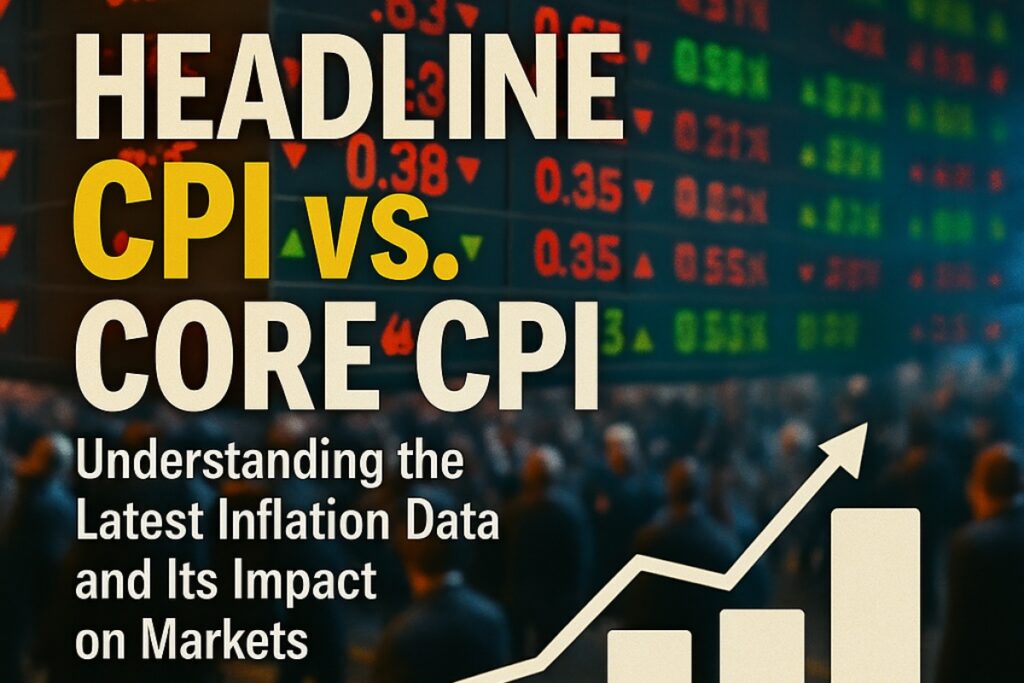
One important economic indicator that affects markets, central bank policies and daily financial decisions between core inflation vs headline inflation . The U.S. Consumer Price Index (CPI) data for April recently revealed headline inflation at 2.3% year-over-year (YoY), which was lower than the anticipated 2.4%, while Core CPI stayed stable at 2.8%, which was in line with forecasts. Market reactions have been conflicted as headline inflation has cooled for the third consecutive month. Lets se the difference between headline CPI vs Core CPI.
Understanding the Difference Between Headline CPI vs Core CPI
Although both the headline and core CPIs are crucial for comprehending inflation, their functions are distinct. The headline CPI gives consumers a broad picture of price changes that have an immediate effect on their daily expenses. Core CPI, on the other hand, eliminates volatile components like food and energy and concentrates on more stable categories. The Federal Reserve and other policymakers frequently use Core CPI to assess long-term inflationary trends. Here is a list between headline CPI vs Core CPI.
Recent Data Highlights
- Headline CPI (YoY): 2.3% (vs. 2.4% expected)
- Core CPI (YoY): 2.8% (in line with expectations)
- Headline CPI (MoM): +0.2% (vs. 0.3% expected)
- Core CPI (MoM): +0.2% (vs. 0.3% expected)
Expert Insights
- The Wall Street Journal’s Chief Economics Correspondent, Nick Timiraos, stressed that falling headline inflation is primarily due to a reduction in the cost of goods like airfare and used cars.
- Market analyst Crypto Auris pointed out that a more dovish policy outlook is supported by cooling inflation, which could help cryptocurrency markets.
- Financial analyst Brenden Dilley pointed out that the Core CPI is still sticky, indicating ongoing underlying price pressures, even though headline inflation is declining.
Market Reactions
- As investors evaluated the ramifications of slowing inflation, stock markets, as represented by indices like $SPX, displayed a range of responses.
- Analysts interpreted the data as evidence of possible support for riskier assets like Bitcoin, and cryptocurrency markets reacted favorably.
- While a rate cut in September is still possible, the likelihood of one in June or July has decreased.
Analysis: Headline CPI vs. Core CPI
Understanding the differences between the headline and core CPIs is essential to comprehending the dynamics of core inflation vs headline inflation:
- Headline CPI: More susceptible to cooling trends in food and energy prices.
- Core CPI: Ongoing price pressures in housing, healthcare and other essential categories, the core CPI is still high.
Why Core CPI Remains Sticky
Core CPI is still high because of ongoing pressures in vital industries like housing and healthcare, even though headline inflation has decreased. The Core CPI is a more accurate indicator of underlying inflation because these categories are less affected by transient changes.
Historical Perspective: How CPI Trends Have Evolved
Looking back over the last ten years, a number of factors have affected inflation, such as shifting consumer behavior, energy price volatility, and disruptions in the global supply chain. Investors can forecast future trends by knowing how these factors have affected headline and core CPI in the past.
How This Affects the Federal Reserve’s Policy
When making decisions, the Fed keeps a careful eye on the Core CPI. Interest rate hikes may continue if the Core CPI keeps rising, but a decline could pave the way for a more dovish approach. Long-term economic growth depends on price stability, as Fed Chair Jerome Powell has underlined.
Implications for Different Asset Classes
- Equities: Growth stocks may benefit if the Federal Reserve adopts a dovish stance due to declining headline inflation.
- Bonds: Bonds may become more appealing if bond yields decline as inflation expectations decline.
- Cryptocurrency: Risky assets like Bitcoin may benefit from a cooling inflation outlook, as noted by Crypto Auris.
Conclusion of Headline CPI vs Core CPI
Core inflation is still stubborn, despite headline inflation continuing to decline, according to the most recent U.S. inflation data between core inflation vs headline inflation. This implies that the Federal Reserve may continue to take a cautious approach and keep a careful eye on core inflation for investors and consumers. Investors ought to keep abreast of impending CPI announcements and modify their plans as necessary.
